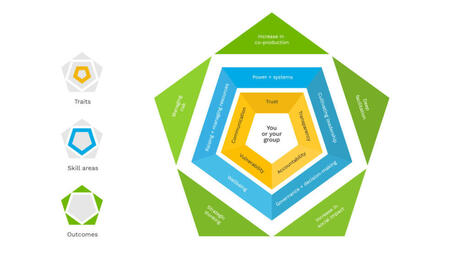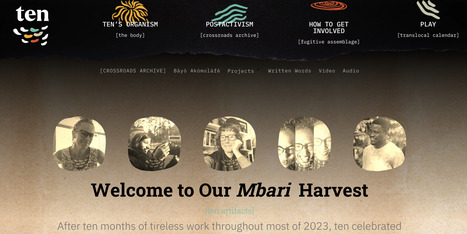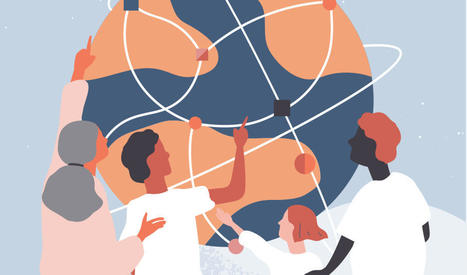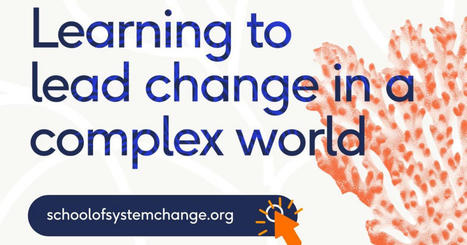 Your new post is loading...
 Your new post is loading...

|
Scooped by
june holley
|
🌱 Healing Collective Trauma through Relationships: Weaving Networks for Reconciliation – Zoom, Tue 18 Jun 2024 - 🌿 Healing Together: Weaving Networks to Transform Trauma
Are you looking for ways to address and heal deep-seated impacts of trauma within your community and societal systems? This interactive session will explore how to create healing-centered networks that provide opportunitie

|
Scooped by
june holley
|
🌳Governance & Consent Decision Making – Zoom, Tue 11 Jun 2024 - 🌟Consent Fosters Equity, Accountability and Transparency
Join us for a workshop that explores how consent-based decision-making can be a powerful tool to create a more inclusive and equitable governance system. Using an appreciative inquiry perspective the workshop will explor

|
Scooped by
june holley
|
We know, you know, everybody knows that social change is never down to just one person. Many hands are needed to make real, long lasting transformation. Yet so often, the organisational processes and structures we fall back on reinforce top-down models of leadership, rather than collective endeavours.

|
Scooped by
june holley
|
A cross-post from the endlessly inventive Dark Matter Labs, launching their “Property and Beyond” Lab . Crisis and/of Property The concept of property is deeply embedded in our modern socio-economic systems. So much so that it is often viewed as sacrosanct, a near-natural law-like means to d

|
Scooped by
june holley
|
This article is part of Illuminate’s Equitable Horizon Blog Series. Find more from this series HERE. Introduction The paper is written from the perspectives and experiences of three Black wom…

|
Scooped by
june holley
|
⚖️ Embodying Social Justice, Diversity, Equity & Inclusion - Somatic Practices for Collective Liberation – Zoom, Tue 28 May 2024 - 🔥 Experiencing the Power of Somatic Practices
In this bonfire circle, we will dive into Diversity, Equity, and Inclusion (DEI) by moving through our relationship to social justice. And when we say “moving through”, we mean it! Through a variety of somatic practices, we will lea

|
Scooped by
june holley
|
The Networks Festival is a month-long gathering in May for funders, convenors, network leaders, companies, and governments come together to deepen our understanding of how to drive social change through networks – and practice centering relationships to transform our world.

|
Scooped by
june holley
|
📣 Funding Social Movements to Accelerate Global Change – Zoom, Thu 23 May 2024 - Investing in movements is not just about supporting individual causes and campaigns; it's about nurturing the very fabric of social change itself.
Movements serve as dynamic catalysts for accelerating social and systemic change. They embody the collective will of communities

|
Scooped by
june holley
|
Cities are defined by various criteria, from political units to built areas identified in satellite images to how people move across geographical space. The proliferation of cell phones around the globe may offer a more complete picture of people's mobility.

|
Rescooped by
june holley
from Papers
|
Andrea Civilini, Onkar Sadekar, Federico Battiston, Jesús Gómez-Gardeñes, and Vito Latora Phys. Rev. Lett. 132, 167401 Understanding how cooperative behaviors can emerge from competitive interactions is an open problem in biology and social sciences. While interactions are usually modeled as pairwise networks, the units of many real-world systems can also interact in groups of three or more. Here, we introduce a general framework to extend pairwise games to higher-order networks. By studying social dilemmas on hypergraphs with a tunable structure, we find an explosive transition to cooperation triggered by a critical number of higher-order games. The associated bistable regime implies that an initial critical mass of cooperators is also required for the emergence of prosocial behavior. Our results show that higher-order interactions provide a novel explanation for the survival of cooperation. Read the full article at: link.aps.org
Via Complexity Digest

|
Rescooped by
june holley
from Papers
|
Laurent Hébert-Dufresne, Antoine Allard, Joshua Garland, Elizabeth A. Hobson & Luis Zaman
npj Complexity volume 1, Article number: 4 (2024) Complexity science studies systems where large numbers of components or subsystems, at times of a different nature, combine to produce surprising emergent phenomena apparent at multiple scales. It is these phenomena, hidden behind the often deceptively simple rules that govern individual components, that best define complex systems. Since these behaviors of interest arise from interactions between parts, complex systems are not counterparts to simple systems but rather to separable ones. Their study therefore often requires a collaborative approach to science, studying a problem across scales and disciplinary domains. However, this approach introduces challenges into the ways collaborations function across traditionally-siloed disciplines, and in the publication of complexity science, which often does not fall cleanly into disciplinary journals. In this editorial, we provide our view of the current state of complex systems research and explain how this new journal will fill an important niche for researchers working on these ideas. Read the full article at: www.nature.com
Via Complexity Digest

|
Rescooped by
june holley
from Papers
|
Francis Heylighen, Shima Beigi, Clement Vidal This report is a first survey of a new, evolutionary narrative, called the Third Story, intended to replace and complement the earlier religious (First) and mechanistic (Second) worldviews. We first argue that the confusions created by a world that is ever more volatile, uncertain, complex and ambiguous (VUCA) have eroded people’s sense of coherence, that is, the degree to which they experience the world as comprehensible, manageable and meaningful. The First Story provides meaning and values, but its descriptions no longer provide an accurate understanding of how the universe functions. The Second Story, which sees the universe as a clockwork mechanism governed by the laws of nature, provides more accurate predictions that allow us to build powerful technologies. However, it does not provide meaning or values. The Third Story sees the universe as self-organizing towards increasing complexity and consciousness, subsequently producing matter, life, mind and society. It understands the fundamental mechanism of evolution as mutual adaptation or “fit” between interacting systems, thus generating synergetic wholes that in turn interact, so as integrate into even more complex wholes. Its implicit value is the search for fitness and synergy, thus inviting individuals to work towards a further integration of the noosphere, i.e. the planetary superorganism formed by humanity, its technological extensions, and the ecosystem. Read the full article at: researchportal.vub.be
Via Complexity Digest

|
Scooped by
june holley
|
April Charlo and Erika Koskela, co-founders of Snqʷeyłmistn, a Salish organization in Montana, USA and Samantha Slade, author of Going Horizontal, co-founder of Percolab, are collaborating to create…
|

|
Scooped by
june holley
|
⛵ Localizing Philantropy: Funding Grassroots and Indigenous Communities – Zoom, Thu 13 Jun 2024 - 🌱 Invest in Innovation: Directing Funds to the Frontlines
Systems change is nuanced and complex, with unique solutions required for different contexts. Local communities possess a deep understanding of their unique challenges and opportunities, collectivel

|
Scooped by
june holley
|
the Tree of Alignment and the overarching tree analogy stand as a unifying, clarifying, and inspiring model. It aids diverse changemakers in collaborating more coherently and effectively towards a shared vision, despite not having detailed knowledge of each other’s actions. This approach underscores the strength and utility of the model in fostering collective understanding and synergy among the varied contributors to the change process.

|
Scooped by
june holley
|

|
Scooped by
june holley
|
We know, you know, everybody knows that social change is never down to just one person. Many hands are needed to make real, long lasting transformation. Yet so often, the organisational processes and structures we fall back on reinforce top-down models of leadership, rather than collective endeavours.

|
Scooped by
june holley
|
🏗️ Building Belonging in Networks: From Inner Work to Liberatory Relationships – Zoom, Wed 5 Jun 2024 - 🍃 Towards Leadership that Connects
We all yearn for belonging and connection and understand that work is needed in both our relationships and ourselves. This bonfire session invites you to explore some of the barriers and pathways to the deeper relationships we nee

|
Scooped by
june holley
|
📖 How to Tell Stories that Captivate Your Network Members, Funders & Partners – Zoom, Wed 5 Jun 2024 - 📖 Unlock the Power of Storytelling
Stories have the unique power to humanize abstract data, making complex networks and systems relatable and understandable. They reveal intricate interconnections, showing how elements influence each other and contribute t

|
Scooped by
june holley
|
📣 Funding Social Movements to Accelerate Global Change – Zoom, Thu 23 May 2024 - Investing in movements is not just about supporting individual causes and campaigns; it's about nurturing the very fabric of social change itself.
Movements serve as dynamic catalysts for accelerating social and systemic change. They embody the collective will of communities

|
Scooped by
june holley
|
Indy Johar’s Dark Matter Labs - and Imandeep Kaur’s Civic Square - have been constant inspirations to the Alternative Global since our foundation. They are naturally cosmolocal , in our terms, because they constantly think of what the localised, strong-community responses to global trends wou

|
Scooped by
june holley
|
The case for relationship-centred communities, organisations and systems What follows is an excerpt from the The Relationships Project’s Case Maker, Putting Relationships First IF YOU WANT TO…

|
Rescooped by
june holley
from Papers
|
Guim Aguadé-Gorgorió, Jean-François Arnoldi, Matthieu Barbier, Sonia Kéfi Ecology Letters Natural systems are built from multiple interconnected units, making their dynamics, functioning and fragility notoriously hard to predict. A fragility scenario of particular relevance concerns so-called regime shifts: abrupt transitions from healthy to degraded ecosystem states. An explanation for these shifts is that they arise as transitions between alternative stable states, a process that is well-understood in few-species models. However, how multistability upscales with system complexity remains a debated question. Here, we identify that four different multistability regimes generically emerge in models of species-rich communities and other archetypical complex biological systems assuming random interactions. Across the studied models, each regime consistently emerges under a specific interaction scheme and leaves a distinct set of fingerprints in terms of the number of observed states, their species richness and their response to perturbations. Our results help clarify the conditions and types of multistability that can be expected to occur in complex ecological communities. Read the full article at: onlinelibrary.wiley.com
Via Complexity Digest

|
Rescooped by
june holley
from Papers
|
Mohsen Mosleh, Rocky Cole, David G Rand Author Notes
PNAS Nexus, Volume 3, Issue 3, March 2024, pgae111, There is considerable concern about users posting misinformation and harmful language on social media. Substantial—yet largely distinct—bodies of research have studied these two kinds of problematic content. Here, we shed light on both research streams by examining the relationship between the sharing of misinformation and the use of harmful language. We do so by creating and analyzing a dataset of 8,687,758 posts from N = 6,832 Twitter (now called X) users, and a dataset of N = 14,617 true and false headlines from professional fact-checking websites. Our analyses reveal substantial positive associations between misinformation and harmful language. On average, Twitter posts containing links to lower-quality news outlets also contain more harmful language (β = 0.10); and false headlines contain more harmful language than true headlines (β = 0.19). Additionally, Twitter users who share links to lower-quality news sources also use more harmful language—even in non-news posts that are unrelated to (mis)information (β = 0.13). These consistent findings across different datasets and levels of analysis suggest that misinformation and harmful language are related in important ways, rather than being distinct phenomena. At the same, however, the strength of associations is not sufficiently high to make the presence of harmful language a useful diagnostic for information quality: most low-quality information does not contain harmful language, and a considerable fraction of high-quality information does contain harmful language. Overall, our results underscore important opportunities to integrate these largely disconnected strands of research and understand their psychological connections. Read the full article at: academic.oup.com
Via Complexity Digest

|
Scooped by
june holley
|
We enable personal and collective agency to cultivate change in the world with a multi-method approach to systems change learning - with networks, organisations and individuals.
|
 Your new post is loading...
Your new post is loading...
 Your new post is loading...
Your new post is loading...



























